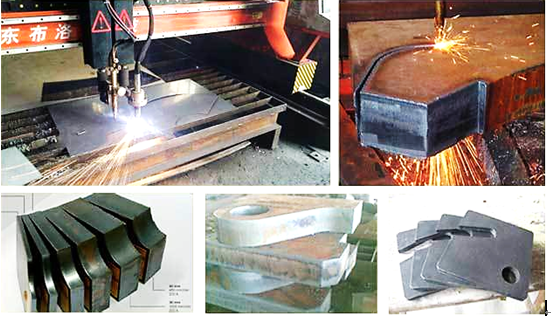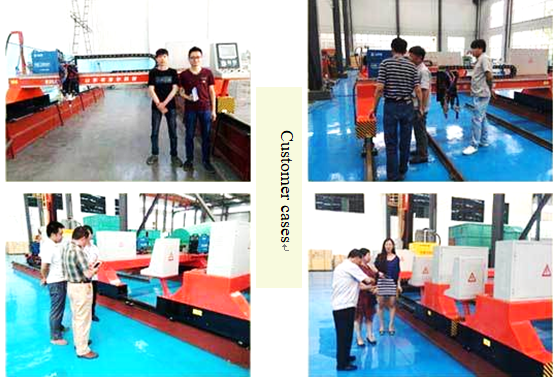Heavy Gantry CNC Cutting Machine
Optional Features:
Parameters
Type
BLDH-Z-4080
BLDH-Z-5080
BLDH-Z-60100
BLDH-Z-80100
Input power
AC380V/50Hz;AC220V/50Hz
Track gauge(mm)
4035
5000
6000
8000
Machine width(mm)
4300
5500
6500
8500
Effective cutting width(mm)
3300
4300
5300
7300
Track length(mm)
8000
8000
10000
10000
Lift(mm)
200
Cutting thickness(mm)
Flame cutting: 5~200Plasma cutting: 1~30(According to the power supply size)
Cutting speed (mm/min)
Flame cutting:100~1000
Plasma
cutting: 450~5000
Idle speed(mm/min)
0~8000
Drive mode
Bilateral drive
System
Shanghai Jiaoda or Beijing Starfire
Operating accurancy
±0.5mm
Cutting
samples
Customer
cases
Automated Plasma Cutter,Heavy Plasma Cutting Machine,Heavy Cnc Cutting Machine,Gantry Flame Plasma Cnc Cutting Machine Shandong Buluoer Intelligent Technology Co., Ltd. , https://www.buluoercuttingmachines.com
Dyestuffs and Inks: Opening up New Fields Synthetic dyes are one of the typical areas in which the overall strength of the market occurs. In 2006, sales of synthetic dyes in Japan accounted for about 1/3 of the 115.4 billion yen recorded in 1991. The development of Japan's synthetic dye industry has shown a structural decline, and special colorants used in the electronic information field have gradually become the focus of development. Flat panel displays and optical recording media are an important part of technological innovation in the field of electronic information, and special colorants are of great importance to flat panel displays and optical recording media manufacturers.
Compared with 2005, sales of printing inks in Japan in 2006 were basically the same. However, the specialty ink market, such as inks used in semiconductor and liquid crystal display color image filters, is rapidly developing. At the same time, the demand for inks for inkjet printers has also increased substantially; the growth of the market for photoprinting inks, coatings, and adhesives is also good.
Varnish and Coatings: Increased R&D The development of new high-performance varnishes and coatings has attracted attention from consumers, and the market demand has also increased. In the past few years, the demand for varnishes and coatings in Japan has been weak, but in 2006 Japan's sales of varnishes and coatings exceeded 2 million tons, mainly due to the rapid development of the Japanese auto industry.
Another factor that stimulates the growth of the paint market is the proliferation of new multifunctional products. Taking building materials as an example, thermal insulation coatings that help to save energy and ease the urban heat island phenomenon have already established a foothold in the market. At the fourth coating exhibition held in Tokyo in April 2006, the heat-insulating paints shined.
In addition to developing high performance coatings and varnishes, the Japan Paint Manufacturers Association is actively training color designers who specialize in color matching designs. Because shape and color are the two main factors that determine the external characteristics of most industrial products, the demand for color matching designers in various industrial fields is growing rapidly. In particular, the view that consumer-oriented color schemes can have a significant impact on product sales is increasingly being accepted by the coatings community.
Agrochemicals: Exploiting overseas markets Statistics from the Japan Crop Protection Association show that the sales volume of agrochemicals for 2006 was down from the previous year.
To open up domestic and foreign markets, Japanese agrochemical manufacturers are developing new reactive intermediates. Since the domestic market in Japan is unlikely to continue to grow, they have focused their development on foreign markets. In February 2007, Phoenix, a pesticide developed by Japan Pesticides Corporation, was a typical example and this product had a sensational effect. Other insecticides are still in development stage Overall, Japanese agrochemical producers still have the potential to expand their share of the global agrochemical market. At present, the market capacity of global agrochemicals is 3 trillion yen. As the demand for bioethanol has led to an increase in corn and rape plantings, the global agrochemical market is expected to continue to grow.
Catalyst: Opportunities and challenges coexist By 2005, Japan’s domestic demand for catalysts had increased for seven consecutive years. Refining catalyst demand dominated the domestic catalyst market in Japan, but it began to turn around in 2006. In 2006, the demand for Japan's refining catalyst market was relatively weak, and the demand for automotive exhaust gas treatment catalyst products that has driven the growth of the Japanese catalyst market has also started to stagnate. At the same time, catalyst manufacturers are developing fuel cell catalysts, some of which will soon be commercialized.
The increase in raw material costs has reduced the profitability of the catalyst industry. In 2006, the sales revenue of Japan's environmental protection catalysts increased by more than 40%, but the production of refinery catalysts was decreasing. However, the catalyst used for petrochemical production and polymerization remained strong. Japan's domestic refining catalyst market is becoming increasingly saturated. Catalyst manufacturers focus their attention on the catalytic cracking of the chemical refining process, crude oil processing, and China, Southeast Asia and other upcoming petrochemical plants. At the same time, the new regulations for automobile exhaust emissions in Japan will come into effect in 2009, which will stimulate the development of Japan's catalyst market for exhaust gas treatment and provide new development opportunities for catalyst manufacturers.


In recent years, due to factors such as the saturation of the domestic market, intensified global competition, and rising raw material costs, Japan's fine chemical industry is struggling. In order to get rid of the predicament, Japan's fine chemical industry started to develop high-value-added functional products, explored overseas markets, and developed new application areas. It broke out with a combination boxing and maintained an overall upward trend in 2006. Analysts believe that although the domestic economy in Japan may continue to grow, the period of steady growth of its fine chemicals market has ended. The future development of Japan's fine chemical industry will see new changes.